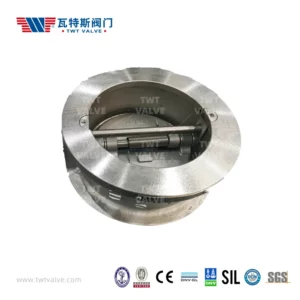Posted on March 1, 2024
How does the wafer type check valve pressure surges?
The wafer type check valve helps mitigate pressure surges in a piping system through its unique design and operational characteristics:
- Quick Response: Wafer type check valves are designed to respond rapidly to changes in flow direction or pressure within the pipeline. When a pressure surge occurs, such as a sudden increase in flow velocity or a water hammer effect, the check valve quickly closes to prevent reverse flow, thereby reducing the impact of the surge.
- Non-Slam Design: Many wafer type check valves feature a non-slam design, which means they close smoothly and quietly without producing a loud slamming noise. This design minimizes the shock waves generated by the closure of the valve, helping to dampen pressure surges and prevent damage to downstream equipment.
- Spring-Assisted Closure: Some wafer type check valves are equipped with spring-loaded discs or pistons that provide additional force to ensure prompt closure of the valve when reverse flow conditions are detected. wafer check valve manufacturer china This spring-assisted closure helps maintain tight sealing and effectively control pressure surges.
- Low Head Loss: Wafer type check valves typically have a streamlined flow path and low pressure drop, which means they introduce minimal resistance to flow during normal operation. This characteristic helps to minimize the buildup of pressure within the pipeline and reduces the intensity of pressure surges.
- Proper Sizing and Installation: Correctly sizing and installing wafer type check valves in the piping system is crucial for effective surge protection. Ensuring that the valves are sized appropriately for the flow rates and pressures in the system, and installed in accordance with manufacturer guidelines, helps optimize their performance in mitigating pressure surges.
- Regular Maintenance: Routine inspection and maintenance of wafer type check valves are essential for ensuring their continued effectiveness in controlling pressure surges. Checking for signs of wear, corrosion, or damage, and promptly addressing any issues, helps maintain the integrity and reliability of the valves over time.
By incorporating these features and considerations, wafer type check valves play a vital role in managing pressure surges within piping systems, helping to protect equipment, prevent leaks, and maintain system integrity.
How does the wafer type check valve facilitate easy access for maintenance?
Wafer type check valves are designed to facilitate easy access for maintenance through several key features:
- Compact Design: Wafer type check valves have a compact and lightweight design, making them easy to handle and maneuver during installation and maintenance procedures. Their streamlined profile allows for convenient access to the valve and surrounding equipment.
- Wafer Body: The wafer body design of these check valves enables them to be installed directly between flanges in the pipeline, without the need for additional mounting hardware or space-consuming components. This simplifies installation and allows for easy removal and reinstallation during maintenance activities.
- Split-Body Construction: Some wafer type check valves feature a split-body construction, allowing the valve to be disassembled into separate halves for maintenance or repair purposes. This design facilitates easy access to internal components, such as the disc, seat, and spring, without the need to disconnect the valve from the pipeline.
- Bolted Bonnet or Cover: Wafer type check valves may incorporate a bolted bonnet or cover mechanism that provides secure sealing while also allowing for straightforward removal for maintenance. By loosening the bolts, wafer type check valve technicians can quickly access the internals of the valve for inspection, cleaning, or replacement of parts.
- Integrated Access Ports: Some wafer type check valves are equipped with integrated access ports or inspection windows that provide visibility into the valve interior without requiring disassembly. These access points allow technicians to visually inspect the condition of internal components and identify any issues that may require attention.
- Standardized Components: Many wafer type check valves use standardized components and assembly techniques, making it easier to source replacement parts and perform maintenance tasks. This simplifies the maintenance process and reduces downtime associated with servicing the valves.
- Clear Markings and Documentation: Manufacturers often provide clear markings, labels, and documentation to aid in the identification and maintenance of wafer type check valves. This includes information on valve specifications, installation instructions, and recommended maintenance procedures, helping technicians perform tasks efficiently and accurately.
Overall, the design features of wafer type check valves are geared towards ensuring easy access for maintenance, allowing technicians to quickly inspect, service, and repair the valves as needed to maintain optimal performance and reliability in the piping system.


